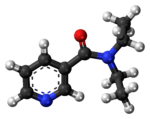Nikethamide
Nikethamide is a stimulant which mainly affects the respiratory cycle. Widely known by its former trade name of Coramine, it was used in the mid-twentieth century as a medical countermeasure against tranquilizer overdoses, before the advent of endotracheal intubation and positive-pressure lung expansion. It is no longer commonly considered to be of value for such purposes.
 | |
 | |
| Clinical data | |
|---|---|
| Other names | Nicotinic acid diethylamide |
| AHFS/Drugs.com | International Drug Names |
| ATC code | |
| Pharmacokinetic data | |
| Elimination half-life | 0.5 h |
| Identifiers | |
IUPAC name
| |
| CAS Number | |
| PubChem CID | |
| ChemSpider | |
| UNII | |
| KEGG | |
| CompTox Dashboard (EPA) | |
| ECHA InfoCard | 100.000.380 |
| Chemical and physical data | |
| Formula | C10H14N2O |
| Molar mass | 178.231 g·mol−1 |
| 3D model (JSmol) | |
SMILES
| |
InChI
| |
| (verify) | |
In alternate terminology, it is known as nicotinic acid diethylamide, which meaningfully emphasizes its laboratory origins, and of which its common name is derived as a blend.
Former and current medical use
.jpg)
Coramine was used by suspected serial killer John Bodkin Adams when treating patient Gertrude Hullett, whom he was suspected of murdering.[1] However, the toxicity of nikethamide is quite low (LD50 rabbits 650 mg/kg oral, LD50 rats 240 mg/kg subcutaneous).
Theodor Morell, Adolf Hitler's personal physician, would inject the German ruler with Coramine when Hitler was unduly sedated with barbiturates. In addition, Morell would use Coramine as part of an all-purpose "tonic" for Hitler.[2]
It is available as a short-acting over-the-counter drug in several South American and European countries, combined with glucose in form of lozenges. It is especially useful for mountain climbers to increase endurance at high altitudes. Contraindications include hypertension, cardiovascular pathologies and epilepsy.[3]
Use in sports
In some sports, nikethamide is listed by the World Anti-Doping Agency as a banned substance. Jaime Huélamo was stripped of his bronze medal at the 1972 Olympic individual cycling road race after testing positive for Coramine.[4] Croatian tennis player Marin Čilić was suspended from competition for nine months after he tested positive for nikethamide in April 2013.[5] This ban was later reduced to four months after Cilic appealed and claimed he had unintentionally ingested it in a glucose tablet bought at a pharmacy.[6] Polish kart driver Igor Walilko was given a two-year ban, later reduced to eighteen months, from competition in 2010 due to testing positive for nikethamide after a win in Germany in July, 2010.[7]
See also
References
- Cullen, Pamela V., "A Stranger in Blood: The Case Files on Dr John Bodkin Adams", London, Elliott & Thompson, 2006, ISBN 1-904027-19-9
- Doyle D (February 2005). "Adolf Hitler's medical care" (PDF). J. R. Coll. Physicians Edinb. 35 (1): 75–82. ISSN 1478-2715. OCLC 49953788. PMID 15825245. Retrieved 2009-03-15.
- Nikethamid, III-3.3, Toxcenter
- https://www.news24.com/xArchive/Olympics2004/InsideTrack/Olympic-dopings-list-of-shame-20040824
- "Marin Cilic: Croatian banned for nine months". BBC News. 16 September 2013. Retrieved 16 September 2013.
- "Cilic cleared to play again after suspension reduced". Tennis. 25 October 2013. Retrieved 25 October 2013.
- "FIA ANTI‐DOPING DISCIPLINARY COMMITTEE; Mr Igor WALILKO; Decision of the Court of Arbitration for Sport" (PDF). 22 September 2011. Retrieved 23 July 2016.